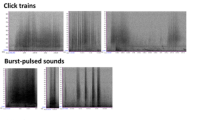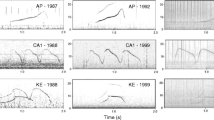Abstract
Bottlenose dolphins (Tursiops truncatus) produce individually distinctive vocalizations—referred to as “signature whistles”—that are thought to function as an individual and conspecific recognition system for maintenance of consistent contact between individuals. Observations and playback experiments were conducted at aquariums to study these whistle–vocal exchanges in bottlenose dolphins. Temporal patterns of vocalization were examined by analyzing the intercall intervals between two consecutive whistles. When a second individual produced a call that was different from the first individual’s vocalization, most of these calls were shorter than 1 s. However, when two consecutive calls were produced by the same individual, the second call rarely occurred within 1 s of the first. These results suggest that a second whistle may be produced by a different caller in response to the first whistle; however, in the case of an absence of a response, the first caller is likely to give further whistles. The results of this acoustic analysis show that the dolphins used in this study mostly used signature whistles during the recorded vocal exchanges.







Similar content being viewed by others
References
Altmann J (1974) Observational study of behaviour: sampling methods. Behaviour 49:227–267
Caldwell MC, Caldwell DK (1965) Individualized whistle contours in bottlenosed dolphins (Tursiops truncatus). Nature 207:434–435
Caldwell MC, Caldwell DK (1968) Vocalization of naive captive dolphins in small groups. Science 159:1121–1123
Caldwell MC, Caldwell DK, Tyack PL (1990) Review of the signature-whistle hypothesis for the Atlantic bottlenose dolphin. In: Leatherwood S, Reeves RR (eds) The bottlenose dolphin. Academic, New York, pp 199–233
Charif RA, Mitchell S, Clark CW (1995) Canary 1.2 user’s manual. Cornell Laboratory of Ornithology, New York
Connor RC, Wells RS, Mann J, Read RW (2000) The bottlenose dolphin: social relationships in a fission–fusion society. In: Mann J, Connor RC, Tyack PL, Whitehead H (eds) Cetacean societies: field studies of dolphins and whales. University of Chicago Press, Chicago, pp 91–126
Cook MLH, Sayigh LS, Blum JE, Wells RS (2004) Signature-whistle production in undisturbed free-ranging bottlenose dolphins (Tursiops truncatus). Proc R Soc Lond B 271:1043–1049
Harley HE (2008) Whistle discrimination and categorization by the Atlantic bottlenose dolphin (Tursiops truncatus): a review of the signature whistle framework and a perceptual test. J Exp Psychol Anim Behav Process 77:243–268
Herzing DL (1996) Vocalizations and associated underwater behavior of free-ranging Atlantic spotted dolphins, Stenella frontalis, and bottlenose dolphins, Tursiops truncatus. Aquat Mamm 22:61–79
Itani J (1963) Vocal communication of the wild Japanese monkey. Primates 4:11–66
Janik VM (1999) Pitfalls in categorization of behaviour: a comparison of dolphin whistle classification methods. Anim Behav 57:133–143
Janik VM (2000a) Whistle matching in wild bottlenose dolphins (Tursiops truncatus). Science 289:1355–1357
Janik VM (2000b) Source levels and the estimated active space of bottlenose dolphin (Tursiops truncatus) whistles in the Moray Firth, Scotland. J Comp Physiol A 186:673–680
Janik VM, Slater PJB (1998) Context-specific use suggests that bottlenose dolphin signature whistles are cohesion calls. Anim Behav 56:829–838
Janik VM, Dehnhardt G, Todt D (1994) Signature whistle variations in a bottlenose dolphin, Tursiops truncatus. Behav Ecol Sociobiol 35:243–248
Janik VM, Sayigh LS, Wells RS (2006) Signature whistle shape conveys identity information to bottlenose dolphins. Proc Natl Acad Sci USA 103:8293–8297
Koda H (2008) Short-term acoustic modifications during dynamic vocal interactions nonhuman primates: implications for origins of motherese. In: Msataka N (ed) The origins of language: unraveling evolutionary forces. Springer, Tokyo, pp 59–73
Kureta Y (2000) Vocal exchanges between familiar cotton-top tamarins during social isolation. Jpn J Anim Psychol 50:95–102
Lang TG, Smith HAP (1965) Communication between dolphins in separate tanks by way of an electronic acoustic link. Science 150:1839–1844
Lilly JC, Miller AM (1961) Vocal exchanges between dolphins. Science 134:1873–1876
Masataka N (1982) A field study on the vocalizations of Goeldi’s monkeys (Callimico goeldii). Primates 23:206–219
Masataka N, Biben M (1987) Temporal rules regulating affiliative vocal exchanges of squirrel monkeys. Behaviour 101:311–319
McCowan B, Reiss D (1995) Quantitative comparison of whistle repertoires from captive adult bottlenose dolphins (Delphinidae, Tursiops truncatus): a re-evaluation of the signature whistle hypothesis. Ethology 100:194–209
McCowan B, Reiss D (2001) The fallacy of ‘signature whistles’ in bottlenose dolphins: a comparative perspective of ‘signature information’ in animal vocalizations. Anim Behav 62:1151–1162
Moody M, Menzel EW (1976) Vocalizations and their behavioral context in the tamarin Saguinus fuscicollis. Folia Primatol 25:73–94
Norris KS, Dohl TP (1980) The structure and functions of cetacean schools. In: Herman LM (ed) Cetacean behavior: mechanisms and functions. Wiley, New York, pp 211–261
Oda R (1996) Effects of contextual and social variables on contact call production in free-ranging ringtailed lemurs (Lemur catta). Int J Primatol 17:191–205
Okayasu N (1987) Coo sound communication. Quat Anthropol 19:12–30
Sayigh LS, Janik VM (2009) Signature whistles. In: Perrin WF, Würsig B, Thewissen JGM (eds) Encyclopedia of marine mammals, 2nd edn. Academic, San Diego, pp 1014–1016
Sayigh LS, Tyack PL, Wells RS, Scott MD (1990) Signature whistles of free-ranging bottlenose dolphins Tursiops truncatus: stability and mother–offspring comparisons. Behav Ecol Sociobiol 26:247–260
Sayigh LS, Tyack PL, Wells RS, Scott MD, Irvine AB (1995) Sex difference in signature whistle production of free-ranging bottlenose dolphins, Tursiops truncatus. Behav Ecol Sociobiol 36:171–177
Sayigh LS, Tyack PL, Wells RS, Solow AR, Scott MD, Irvine AB (1998) Individual recognition in wild bottlenose dolphins: a field test using playback experiments. Anim Behav 57:41–50
Sayigh LS, Esch HC, Wells RS, Janik VM (2007) Facts about signature whistles of bottlenose dolphins, Tursiops truncatus. Anim Behav 74:1631–1642
Shane SH, Wells RS, Würsig B (1986) Ecology, behavior and social organization of the bottlenose dolphin: a review. Mar Mamm Sci 2:34–63
Smolker RA, Richards AF, Connor RC, Pepper JW (1992) Sex differences in patterns of association among Indian Ocean bottlenose dolphins. Behaviour 123:38–69
Smolker RA, Mann J, Smuts BB (1993) Use of signature whistles during separations and reunions by wild bottlenose dolphin mothers and infants. Behav Ecol Sociobiol 33:393–402
Snowdon CT, Cleveland J (1984) “Conversations” among pygmy marmosets. Am J Primatol 7:15–20
Snowdon CT, Hodun A (1985) Troop-specific responses to long calls of isolated tamarins (Saguinus mystax). Am J Primatol 8:205–213
Soltis J, Leong K, Savage A (2005) African elephant vocal communication I: antiphonal calling behaviour among affiliated females. Anim Behav 70:79–587
Sugiura H (1993) Temporal and acoustic correlates in vocal exchange of coo calls in Japanese macaques. Behaviour 124:207–225
Sugiura H (1998) Matching of acoustic features during the vocal exchange of coo calls by Japanese macaques. Anim Behav 55:673–687
Sugiura H (2001) Vocal exchange of coo calls in Japanese macaques. In: Matsuzawa T (ed) Primate origins of human cognition and behavior. Springer, Tokyo, pp 135–154
Tyack PL (1986) Whistle repertoires of two bottlenose dolphins, Tursiops truncatus: mimicry of signature whistles? Behav Ecol Sociobiol 18:251–257
Tyack PL (2000) Dolphins whistle a signature tune. Science 289:1310–1311
Watwood SL, Tyack PL, Wells RS (2004) Whistle sharing in paired male bottlenose dolphins, Tursiops truncatus. Behav Ecol Sociobiol 55:531–543
Watwood SL, Owen ECG, Tyack PL, Wells RS (2005) Signature whistle use by temporarily restrained and free-swimming bottlenose dolphins, Tursiops truncatus. Anim Behav 69:1373–1386
Wells RS, Scott MD (2009) Common bottlenose dolphin. In: Perrin WF, Würsig B, Thewissen JGM (eds) Encyclopedia of marine mammals, 2nd edn edn. Academic, San Diego, pp 249–255
Wells RS, Scott MD, Irvine AB (1987) The social structure of free-ranging bottlenose dolphins. In: Genoways HH (ed) Current mammalogy. Plenum, New York, pp 247–305
Winter P, Ploog D, Latta J (1966) Vocal repertoire of the squirrel monkey (Saimiri sciureus), its analysis and significance. Exp Brain Res 1:359–384
Acknowledgments
We would like to thank S. Hasegawa of Minamichita Beachland Aquarium, K. Matsuzaki of Shinagawa Aquarium, and T. Tobayama of Kamogawa Sea World, for allowing us the opportunity to study at the aquariums. We also thank the staff of the aquariums, who assisted with data collection for this study. We are grateful to M. Kashihara, Y. Asai, K. Kuroyanagi, H. Kobayashi and T. Kirihata for their suggestions and help during the study. We express our hearty thanks to Dr. M. Amano and Dr. T. Akamatsu for their valuable advice and discussions. The manuscript was improved by comments provided by Dr. L.S. Sayigh, Dr. A. Takemura, Dr. K. Kawaguchi, Dr. M. Terazaki, Dr. I. Aoki and anonymous reviewers. This study was supported by a research fellowship provided to F.N. from the Japan Society for the Promotion of Science for Young Scientists, and by the Scientific Research Fund of the Ministry of Education, Science and Culture of Japan (No. 08-04531).
Author information
Authors and Affiliations
Corresponding author
About this article
Cite this article
Nakahara, F., Miyazaki, N. Vocal exchanges of signature whistles in bottlenose dolphins (Tursiops truncatus). J Ethol 29, 309–320 (2011). https://doi.org/10.1007/s10164-010-0259-4
Received:
Accepted:
Published:
Issue Date:
DOI: https://doi.org/10.1007/s10164-010-0259-4




